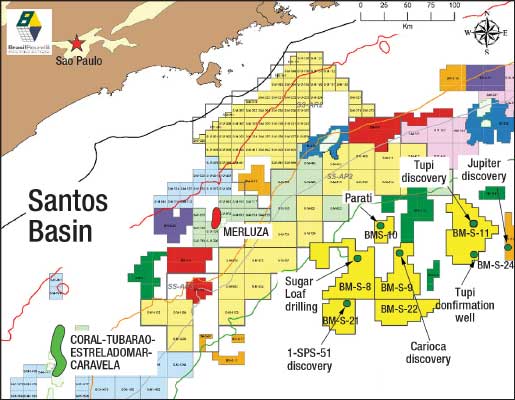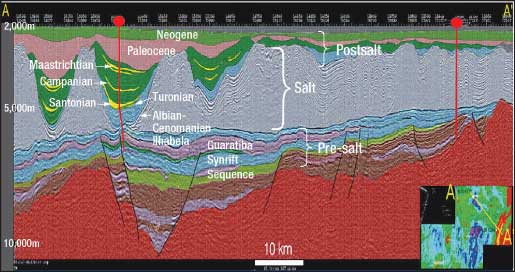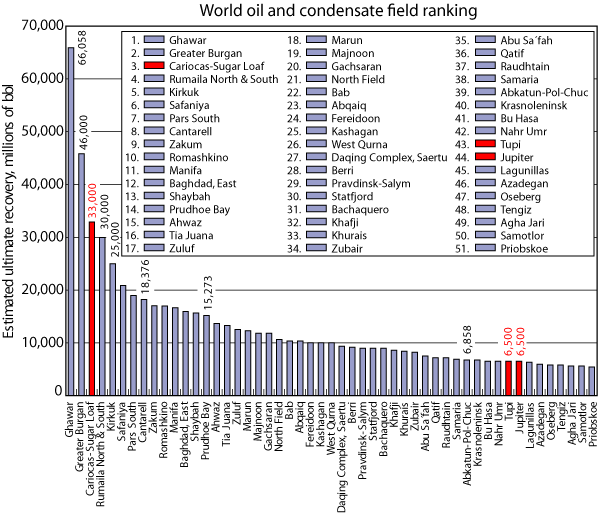What's new in exploration
Three super-giant fields discovered in Brazil's Santos Basin
Three super-giant fields discovered offshore Brazil Petrobras recently announced the discovery of three super-giant oil fields in Brazil’s offshore Santos Basin. The company confirmed its Tupi discovery on Block BM-S-11 (Fig. 1) on November 8, 2007 and stated that the field has probable recoverable reserves between 5 and 8 billion bbl of light oil. It now appears that another, possibly much larger, oil field called Carioca-Sugar Loaf has been discovered about 50 mi west of Tupi. The Carioca discovery well (1-SPS-050) was spudded in April 2007 on Block BM-S-9. The well reached a 21,876-ft TD in the pre-salt Aptian Guaratiba Formation in July 2007. It tested 2,900 bpd of 27°API oil and 2 MMcfgd. A third discovery, the Jupter well, was announced on January 21.
Two other subsalt tests were drilled to the west of Carioca during the fourth quarter of 2007. The first of these is Well 1-SPS-51 on Block BM-S-21, about 50 mi southwest of the Carioca location. Petrobras (operator) and partners Galp Energia and BG Group Plc said that the well proved a light oil field in a pre-salt layer in the basin. The well is located 174 mi off the coast of the State of São Paolo in 7,329 ft of water, and was drilled to a 17,552-ft TD. The second subsalt test is the Sugar Loaf well on Block BM-S-8, about 30 mi northeast of 1-SPS-51 and 30 mi west of Carioca. Unofficial, but credible, reports have suggested that these new wells may be testing the same large structure discovered at Carioca. If true, the feature may cover almost 1,000 sq mi. On December 11, UBS Pactual in Rio de Janeiro reported that the Carioca-Sugar Loaf feature “touches four blocks: BM-S-22 and BM-S-9 have ‘large stakes’ in Sugar Loaf; BM-S-21 has a medium stake; and BM-S-8 a small stake.” A week later, Next Energy News wrote that “according to officials at Petrobras, Sugar Loaf field may produce up to 40 billion bbl of oil...Preliminary exploration of the area has determined that Sugar Loaf field is five times the size of Tupi field.” Just before the November 27 opening of Brazil’s Bid Round 9, the national petroleum agency, ANP, withdrew 40 blocks with significant subsalt potential from the auction based on the Tupi confirmation and on new information from drilling. On December 20, Petrobras posted an official statement on its website confirming that the 1-SPS-51 well was an indicated discovery based on interpretation of drilling results and logs, but that no tests had yet been conducted. On January 21, a third discovery, Jupiter, was announced on the BM-S-24 Block. Petrobras said that the 1-RJS-652 Jupiter well, located 24 mi to the east of Tupi, is an important gas condensate discovery. The company also said that this structure was similar in size to Tupi. The well had 394 ft of pay and a 17,231-ft TD. Jupiter apparently adds another 5-8 billion bbl to the recoverable reserves already announced for Tupi. Exploration results in the Santos Basin prior to Tupi had been disappointing. Only about 115 exploratory wells have been drilled in the basin, compared to more than 1,100 wells in the Campos Basin to the north. Cumulative production is about 260 MMcfg from Merluza Field and 42 million bbl of oil from the Coral-Tubarao-Estela do Mar-Caravela Field complex, Fig. 1. Estimated ultimate recovery from Merluza is 305 MMcfg, and 228 million bbl of oil and 245 Bcfg from Coral-Tubarao-Estela do Mar-Caravela (IHS). Exploration has focused on relatively shallow post-salt clastic objectives, which are poorer reservoirs than correlative intervals in the Campos Basin, Fig. 2. Principal hydrocarbon reservoirs include Lower-Middle Albian carbonates of the Guaruja Formation and Turonian turbidite sandstones of the Ilhabela Member of the Itajai-Acu Formation. Source rocks for the petroleum system are Lower Cretaceous lacustrine shales of the sub-salt Guaratiba Formation.
The Tupi discovery lies beneath a layer of Lower Cretaceous (Aptian) salt that is more than 6,500 ft thick. Source and reservoir rocks are contained within the syn-rift Lower Cretaceous (Barremian to Aptian) Guaratiba Formation. Reservoirs consist chiefly of lacustrine carbonates and associated coastal plain, fluvial and shallow marine clastic and carbonate facies. Traps are formed in pre-rift and syn-rift reservoirs by tilted fault blocks, horsts and grabens that are overlain and sealed by salt. Guaratiba source rocks are thought to be equivalent to the Lagoa Feia Shale source rocks of the adjacent Campos Basin. Oil from the Tupi area is 28-30°API with a gas/oil ratio of about 15-20%. Oil viscosity averages 1 cp, and the oil contains significant paraffin. Associated gas contains 8-18% CO2. Tupi is located 186 mi offshore in water 7,220 ft deep. The reservoir is a 250-ft thick, oil-saturated, porous carbonate unit previously unknown in Brazil. It is divided into three sequences, with the uppermost interval containing more than half of the reserves. Initial reservoir pressure is 8,232 psi. Testing indicates potential flowrates of 15,000-20,000 bopd per well. However, heterogenous, laminated carbonate lithologies may result in variable reservoir quality. Horizontal drilling and hydraulic fracturing are being considered by Petrobras. Tupi reservoir rocks may be similar to the Toca carbonates of the Lower Cretaceous (Barremian-Aptian) Bucomazi Formation in West Africa. At the Kambala Field in Cabinda, Angola, Toca reservoirs are 75 to 300 ft thick and consist of partially to fully dolomitized carbonates that have matrix porosities of 2-10% and very low permeability. At Kambala, production is controlled by faulting and fracturing and, while the field contains more than 1 billion bbl of oil in place, cumulative production after 30 years is less than 50 million bbl. If reports about the potential size of the Carioca-Sugar Loaf structure prove correct at an estimated 33 billion bbl of oil (the mean of 25 and 40 billion bbl), and Tupi and Jupiter reserve estimates are accurate at 6.5 billion barrels each (the mean of 5 and 8 billion bbl), Carioca-Sugar Loaf would be the third-largest oil field in the world. It would also be the largest field discovered in the last 30 years, with Tupi-Jupiter being the 6th largest discovered in that timeframe, Fig. 3. For further comparison, Prudhoe Bay is the largest field in the US, with 15.2 billion barrels of recoverable oil, and East Texas Field is the second largest with 5.4 billion bbl. It is unlikely that the Carioca-Sugar Loaf structure will be a single field; it will probably be a complex of somewhat smaller fields, similar to the emerging deep GOM Wilcox play, with each perhaps averaging the size of Tupi.
Reservoir quality and heterogeneity are the greatest risk factors from a geoscience perspective. Well engineering challenges include drilling and maintaining production casing through the salt, and possible fracture stimulation and secondary recovery in reservoirs that are in 7,000 ft of water and at drilling depths greater than 22,000 ft. Withdrawal of key blocks from Brazil’s ANP Bid Round 9 is disquieting, depending on the reason for withdrawal. Perhaps it is an early example of the sort of resource nationalism that some have predicted as global oil supplies decline. It is more likely, however, that this action reflects an effort by the ANP to ensure maximum bid levels once more is known about the size of the subsalt play. Despite risks and challenges, these discoveries represent the most important oilfield discoveries in decades. If Tupi-Jupiter and Carioca-Sugar Loaf are included, half of the 50 largest oil fields in the world were found before 1960, and 87% before 1980. The real message of these discoveries is that we must not lose sight of the as-yet unknown, but possibly great, potential of basins that are often the exclusive domain of national oil companies. IHS provided information about the Santos Basin petroleum system as well as current drilling, testing and key scouting information. Their ongoing support of this column is greatly appreciated.
|
|||||||||||||||||
- Quantum computing and subsurface prediction (January 2024)
- Machine learning-assisted induced seismicity characterization of the Ellenburger formation, Midland basin (August 2023)
- Regional Report: Guyana-Suriname (July 2023)
- What's new in exploration (March 2023)
- Regional Report: Brazil (February 2023)
- Seismic and its contribution to the energy transition (January 2023)







